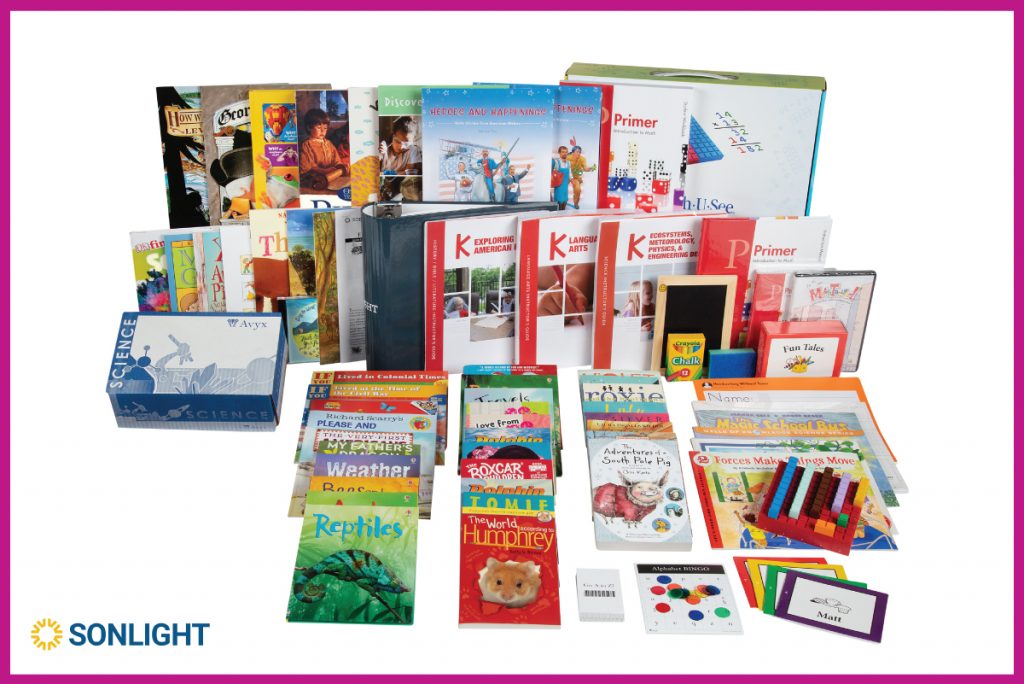This post was originally published as Finally, a Kindergarten American History Curriculum! on Oaxacaborn blog. It is reposted here with permission of the author, Gina Munsey.
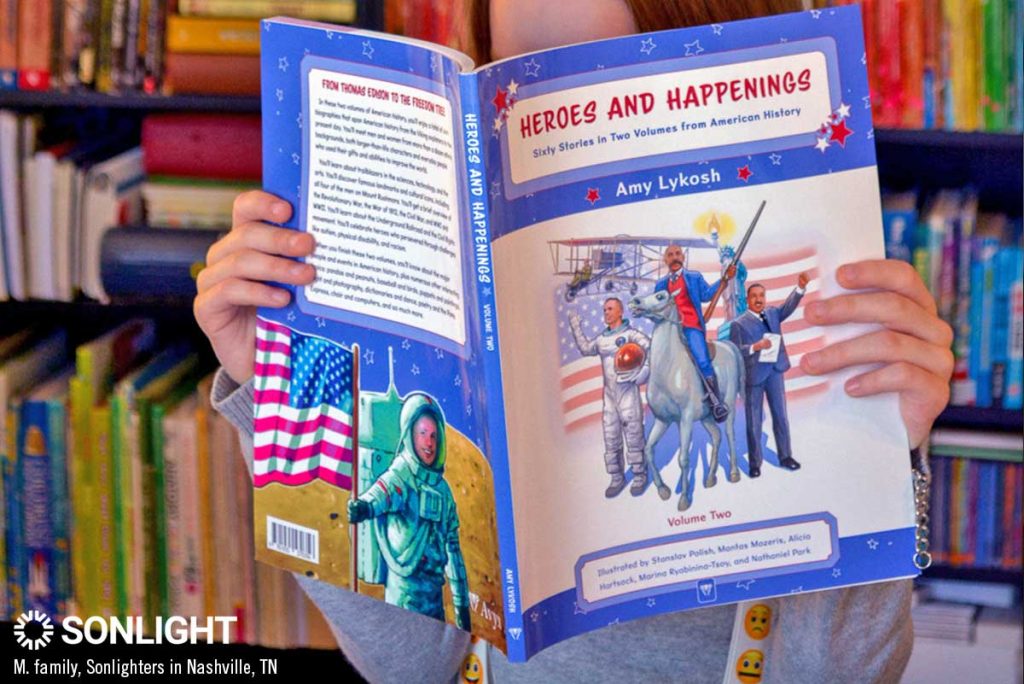
Does an accurate American history curriculum for kindergarten actually exist?
A good homeschool history curriculum is difficult to find, isn’t it? And US history is particularly hard to teach. I have very little tolerance for oversimplified books which whitewash the complexity of our nation’s beginnings, idolize outward morality, virtue, and character, or put Columbus and Washington on a pedestal of American exceptionalism. But most truly accurate US history books are geared toward a much older audience, and aren’t designed to give a broad sweeping overview to sensitive kindergarteners or first graders. American history is messy, ugly, grim, and often brutal. Teaching true American history to small children — even with picture books — is not easy.
So how do we find accurate US history books which will capture the tender imaginations of precious five- and six-year-olds?
A diverse and global worldview is so important to me. When my daughter started kindergarten several years ago, we chose to begin with Sonlight’s overview of world history and cultures (Sonlight’s new American history curriculum for kindergarten didn’t exist yet). As someone who spent my early years outside the United States, I think it’s crucial for kids — especially Christian kids! — to see God’s hand on the entire globe. And as a second-generation homeschooler, I have never been impressed with how some curriculum publishers handle elementary US history, anyway. Many tend to over-emphasize America’s place in the vast global world God created, gloss over the nuanced complexity of multifaceted historical figures, and simplify history to the point of inaccuracy.
Yet as Americans, we need to teach our kids about our nation’s beginning, right? We need teach our kids about all the tangled threads of the early years — all the stories — and show them how these threads been knotted and woven together into the nation we have today.
So I’m really excited about Sonlight’s brand-new American history curriculum for kindergarten!
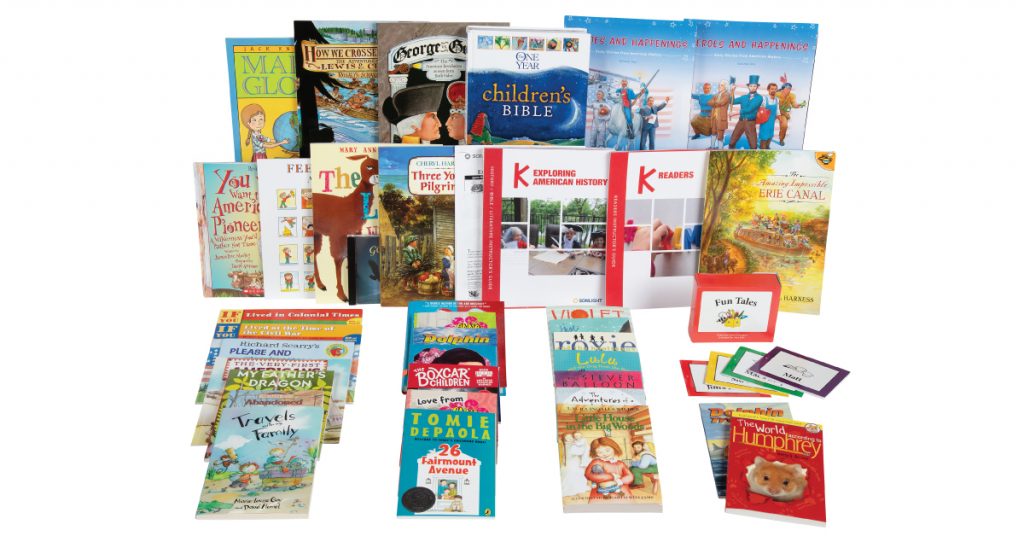
A Sonlight education is a literature-based education, so it’s no surprise that Sonlight’s new Kindergarten program, Exploring American History tells a gentle, age-appropriate story of our nation’s beginnings through dozens and dozens of interconnected stories.
Using a combination of
- picture books,
- read-alouds,
- a bonus book list,
- an Instructor’s guide, and
- a brand-new two-volume history spine called Heroes & Happenings,
five- and six-year-olds can see how the threads of American history weave together, knots and tangles and all.
Exploring American History: History / Bible / Literature K (or HBL K, for short) introduces kids to men and women such as
- African-American inventor Benjamin Banneker,
- Cherokee linguist Sequoyah,
- first female doctor Elizabeth Blackwell,
- abolitionist Harriet Tubman,
- daredevil pilot Ruth Law, and
- so many more.
But before I tell you more about Heroes & Happenings, the newly-published history spine, let’s pause here and quickly talk about how Sonlight is formatted.
An overview of Sonlight’s History / Bible / Literature (HBL) format
HBL stands for History, Bible, and Literature. There’s an HBL kit for each grade — click to see the huge stack of books included in the kindergarten HBL — which contains everything you need to teach
- history,
- social studies,
- timeline,
- geography,
- Bible,
- reading, and
- literature,
in the form of really really great books, all scheduled out for you in a magical Instructor’s Guide.
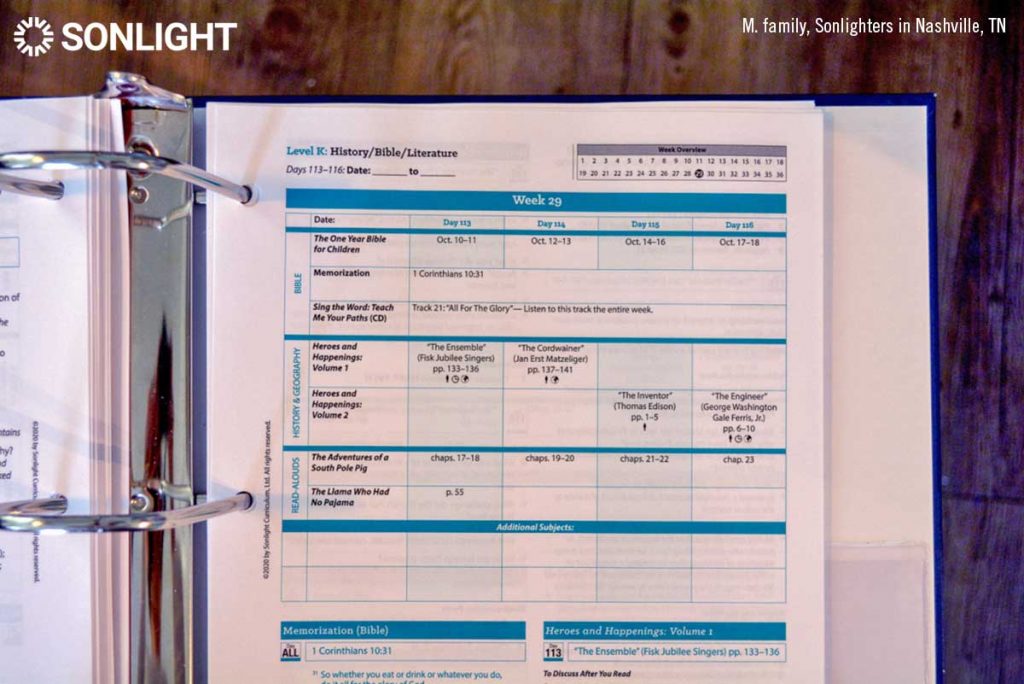
A Sonlight Instructor’s Guide is open-and-go, and contains…
- …weekly schedule grids,
- daily page-by-page reading schedules for every single book,
- Scripture memory verses,
- comprehension questions,
- oral narration cues,
- a laminated map and an easy way to integrate geography,
- cultural literacy notes,
- vocabulary definitions,
- timeline prompts, and
- additional teaching notes.
If you want to use Sonlight for more than history, bible, and literature, Sonlight also offers an all-subjects package. This complete grade set includes
- the HBL and Instructor’s Guide discussed above, plus
- math,
- science, and
- language arts.
In this review, though, I’m focusing particularly on the history portion of Exploring American History: History / Bible / Literature K. In HBL K, history takes on the form of
- Heroes and Happenings, Vol. 1
- Heroes and Happenings, Vol. 2
- the Instructor’s Guide
- picture books about history, and
- an enormous bonus booklist — 250 ADDITIONAL TITLES! (More on that in a bit.)
Let’s talk about Heroes and Happenings, the new history spine.
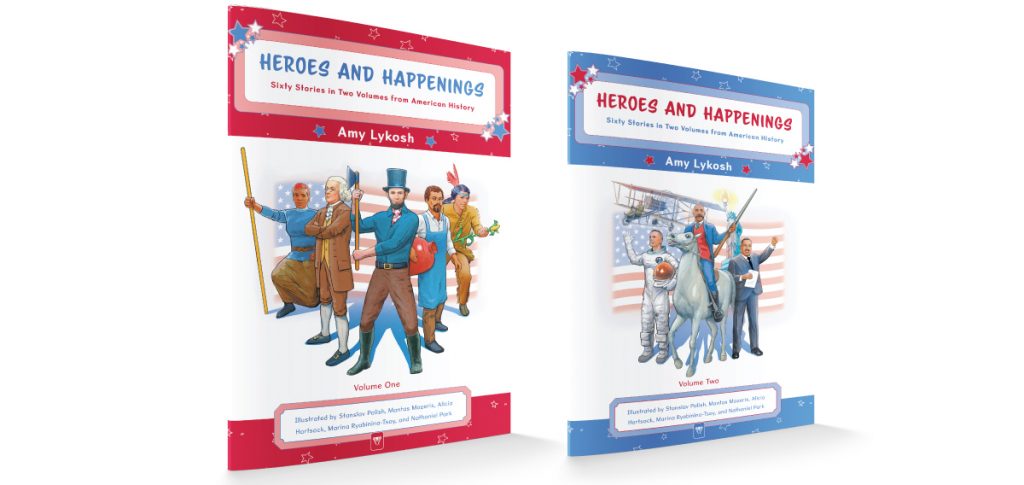
Heroes and Happenings is a Sonlight-exclusive, written specifically for this kindergarten curriculum. It’s a two-volume paperback set, illustrated by children’s book artists.
- Volume One: Leif Erickson (c. 1000) to Jan Matzeliger (c. 1850)
- Volume Two: Thomas Edison (c. 1870) to Temple Grandin (current day)
Each volume is around 150 full-color glossy pages, for a total of 60 stories across 300 pages. What a lot of stories! Although the books progress chronologically, each chapter can stand alone, too. This makes it a great reference book for elementary-age kids who are learning to write research papers, so keep it around after kindergarten ends!
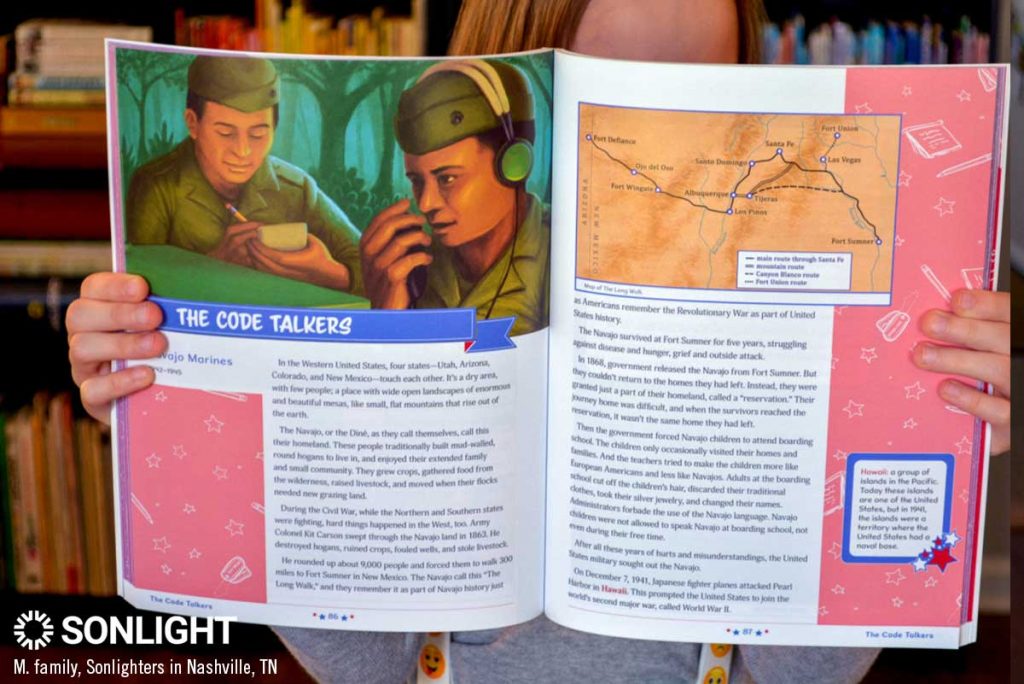
Each of the sixty stories centers around a specific person or event, with a length of about four pages (two 2-page spreads) — just right for young attention spans. And every single page is illustrated, so there’s always something for your little learner to look at as you read aloud.
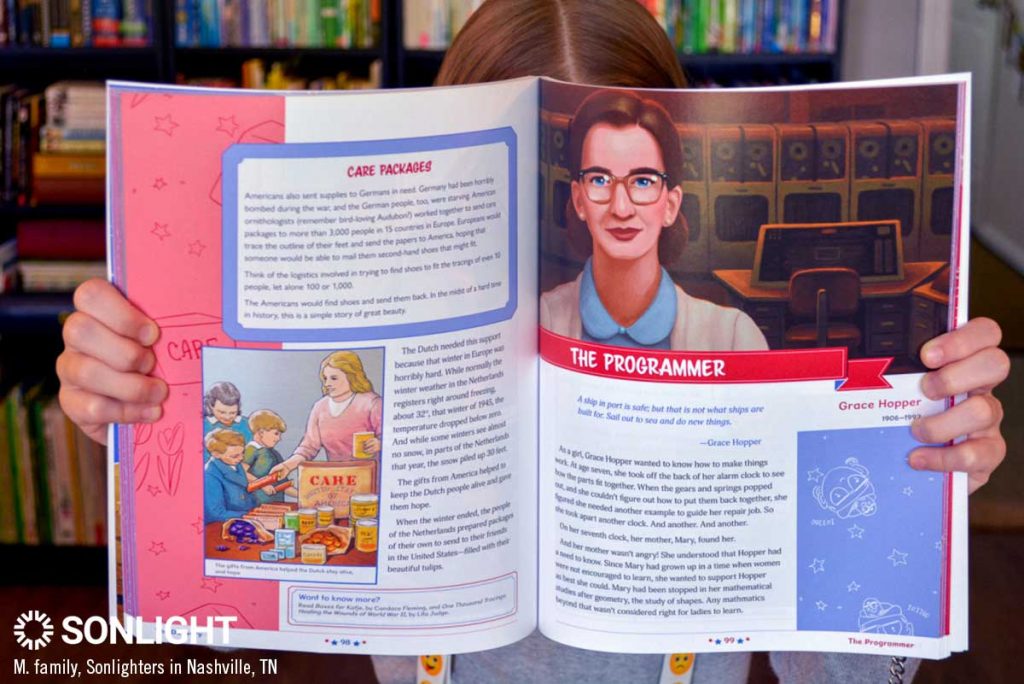
Heroes and Happenings hits the high points of American history, of course, telling the stories of the Stamp Act and the Constitution Convention through to Westward Expansion and the moon landing. But Sonlight always does a really good job teaching cultural literacy, too. This kindergarten history course also contains all sorts of delightful and unusual tidbits, such as the Ferris wheel, the Macy’s Thanksgiving Day parade, bonsai trees, ballet, computer programming, and more.
I also really love the sidebars full of fascinating vocabulary definitions, and all the colorful illustrated maps included alongside the illustrations. Between the
- biographies,
- additional reading lists,
- cultural literacy topics,
- maps, and
- vocabulary highlights,
there are a nearly infinite number of opportunities here for rabbit trails. This homeschool curriculum is excellent for encouraging curiosity and nurturing lifelong learners.
How picture-book based is Sonlight’s new American history program?
Heroes and Happenings is full-color, illustrated by picture-book artists, and written in a narrative style which makes it a delight to read aloud. Depending on if you purchase the 4-day package or the 5-day package, there are either 8 or 10 American history picture books included in the Sonlight package and scheduled in to the Instructor’s Guide daily and weekly schedules.
But there’s the potential for literally hundreds more books.
Yes, hundreds.
A bonus list of 250 US history books, recommended by Sonlight
At the end of every Heroes and Happenings chapter, a useful “Want to know more?” section lists at least additional book suggestions. These are a good mix of popular title and hidden gems, along with Coretta Scott King Award books and Caldecott winners. (And there are occasional notes about the books’ content; for instance, the author lists d’Aulaires’ Columbus, but warns it has “more myths and stories about Columbus rather than facts.”)
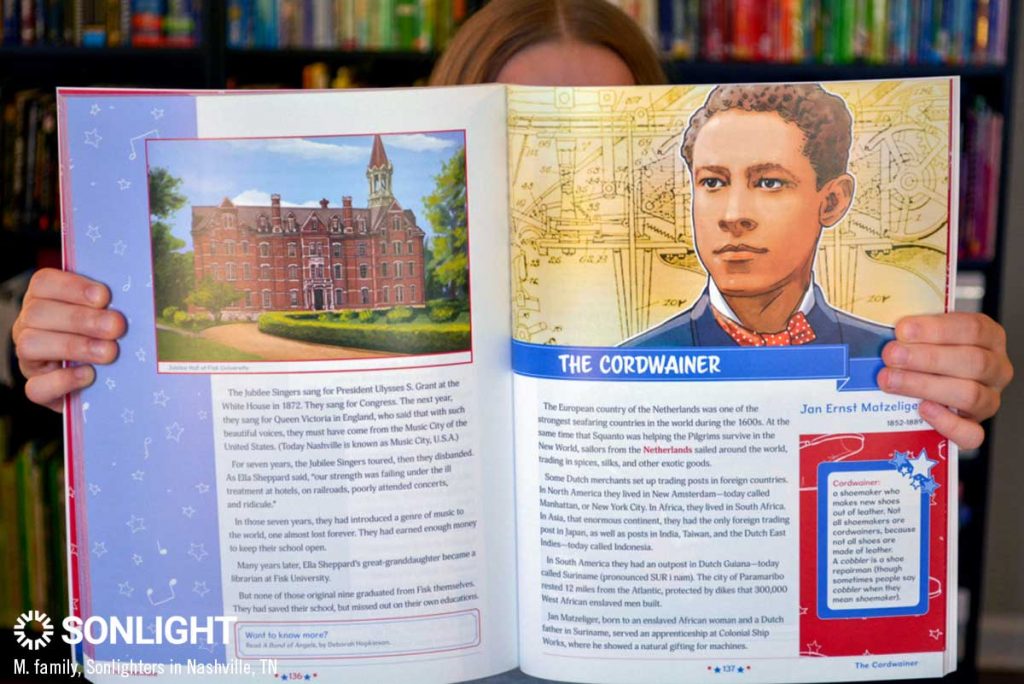
The last few pages of each volume of Heroes and Happenings also contain an appendix of even more book recommendations, organized chronologically by century. I counted through both volumes by hand, and between the end-of-chapter recommendations and the additional booklist in the appendices, there are 250 total book recommendations.
Two-hundred and fifty! This is such a unique and wonderful bonus feature, and not something I’ve ever seen before from Sonlight.
If Sonlight were to have included all of these picture books and juvenile literature selections in the curriculum package, it would have made the bundle absurdly cost-prohibitive, I am sure. Instead, by listing them throughout Heroes and Happenings, Sonlight gives you the option to enrich your experience by reading further and deeper, should you so choose.
(Of course, you don’t have to; the history curriculum is already full and rich as-is. One of Sonlight’s big draws is its utter simplicity; simply open and go! But having access to all these additional book titles is a really incredible perk.)
How does Sonlight’s new kindergarten history program tell the stories of indigenous people and people of color?
When I chatted with friends about this new kindergarten history program, questions about accurate portrayal popped up again and again.
- “I’m curious to hear how it handles race.”
- “Is this less ethno- and Eurocentric than other curriculums?”
- “Is [it] from a colonizer’s perspective?”
- “How are women represented?”
- “How white-washed is it?”
- Are “multiple voices and views are represented?”
These are all important questions. As parents, we have an enormous responsibility
- to equip our children to rightly handle truth (Timothy 2:15),
- to love those around us (Mark 12:30-31), and
- to act justly, love mercy, and walk humbly before God. (Micah 6:8)
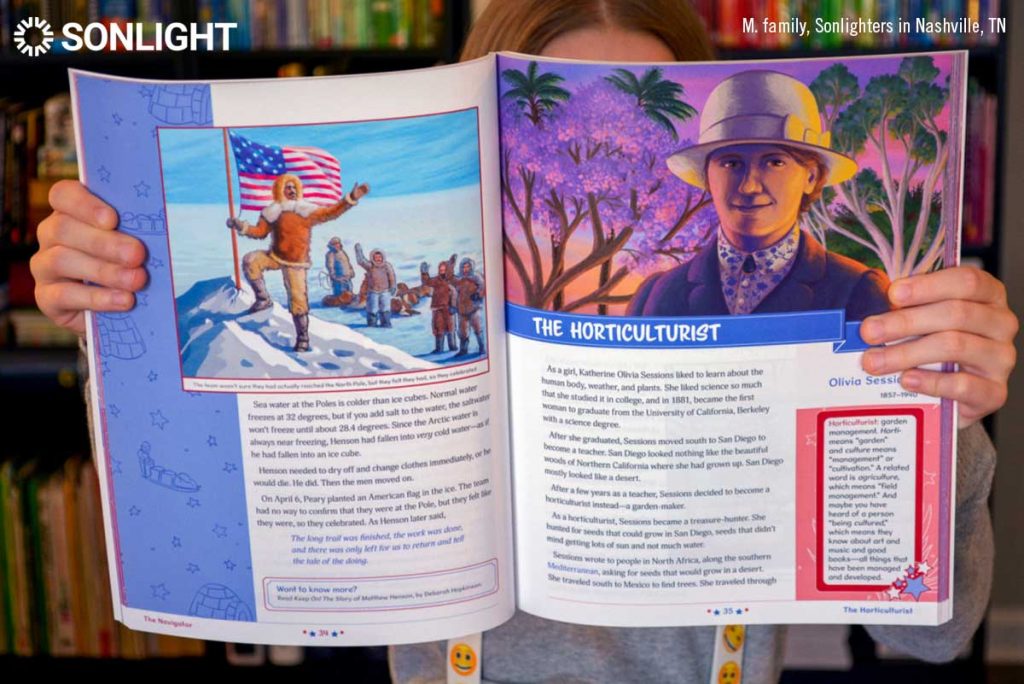
We need to make correct choices for our family, and evaluate wisely. The books we read and the media we consume play a large part in shaping our worldview, for better for worse. Let’s break down the content in Heroes & Happenings numerically:
- 3 of the 60 stories are about Native Americans (Squanto, Sequoyah, and the Navajo Code Talkers)
- 11 of the 60 stories are about African-Americans (David Drake, Bass Reeves, Martin Luther King Jr., and more)
- 12 of the 60 stories are about women (Temple Grandin, Grace Hopper, Harriet Tubman, and more)
- 15 of the 60 stories are about events (the Constitutional Convention, immigration, the Statue of Liberty, the Yamaki pine, and more), and
- 33 of the 60 stories are about men (Randolph Caldecott, John James Audubon, Noah Webster, and more.)
I appreciate how the book doesn’t spend a disproportionate amount of time on pilgrims and pioneers, but spans a broad range of topics, interests, and timelines.
When I’m assessing an American history book, after a scan through the table of contents for a skeletal overview, I also like to physically flip to a few specific sections and spot-read. Glancing at these hot topics generally gives me peek into the author’s perspective, and gives me an idea of what sort of worldview will be communicated to my children. Here are some excerpts and pull-quotes from Heroes & Happenings, so you can assess the book as well.
On the colonists —
“When European settlers came to North America, the people who already lived there…didn’t like having their lands taken over.
Imagine how upsetting it would be if twelve decided to come in to your house, eat your food, use your bathroom, and sleep in your bed. Maybe you could handle it if those twelve people stayed for a week. You might even find it fun if you liked the people.
But now imagine those twelve people stayed in your house for the rest of their lives. They would marry, and have children — it would be too much.
Something like this happened to the Native Americans. The European settlers came, and took over Native American land, and stole their food — it was too much.”
On Tisquantum / Squanto —
“The Europeans didn’t just kidnap Patuxet men, they also brought an unwelcome visitor to them: disease.”
On Thomas Jefferson —
“Thomas Jefferson had written the Declaration of Independence, in which he said, ‘that all men are created equal, that they are endowed by their creator will certain inalienable Rights, that among these are Life, Liberty, and the pursuit of Happiness.’ Jefferson wrote that, but he didn’t act as if all men were created equal — he owned many enslaved men and women.
…Jefferson claimed that he wished the enslaved could soon be in a better condition…Although Jefferson wrote this, he did not actually free any of his enslaved people, and freed only a few in his will. This injustice would not end with Jefferson, unfortunately.”
On the Navajo —
“The government forced Navajo children to attend boarding school…the teachers tried to make the children more like European Americans and less like Navajos. Adults at the boarding school cut off the children’s hair, discarded their traditional clothes, took their silver jewelry, and changed their names. Administrators forbade the use of the Navajo language…even during their free time.”
Sonlight never shies away from hard topics (here are 5 reasons to read books about difficult things.) Throughout every Sonlight course, parents are encouraged to engage their child in meaningful conversations — there are even dialogue prompts in the Instructor’s Guide to help start these super-important discussions.
Talk to your kids. No matter what curriculum you choose, it can never replace relationships and conversations. No book can replace empathy, kindness and courage. No history program can replace critical thinking, wisdom, discernment, or teaching our kids how to think and evaluate what they’re reading.
So talk to your kids.
Model Christ for your kids.
Be the light in a dark and broken world.
And go download a free preview of Exploring American History – just click on the Samples tab!
